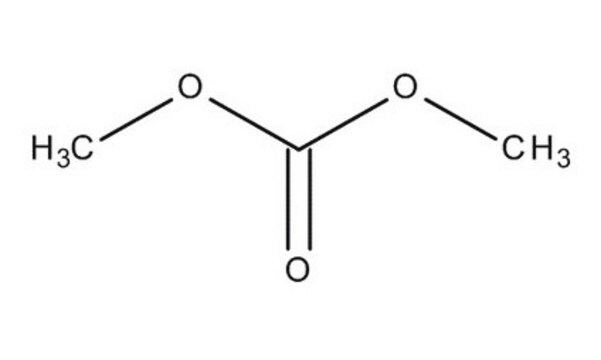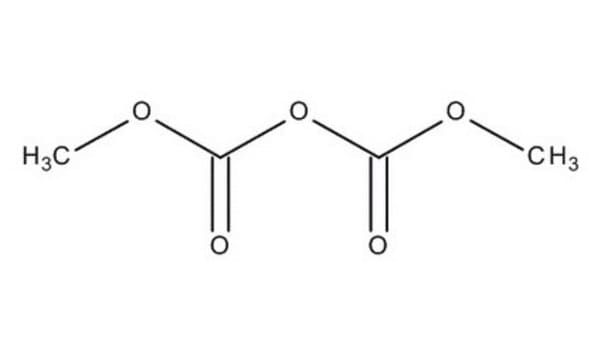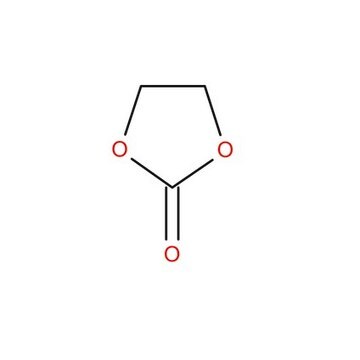D152927
Dimethyl carbonate
ReagentPlus®, 99%
Synonyme(s) :
Carbonic acid dimethyl ester
About This Item
Produits recommandés
Densité de vapeur
3.1 (vs air)
Niveau de qualité
Pression de vapeur
18 mmHg ( 21.1 °C)
Gamme de produits
ReagentPlus®
Pureté
99%
Forme
liquid
Caractéristiques du produit alternatif plus écologique
Less Hazardous Chemical Syntheses
Safer Solvents and Auxiliaries
Design for Degradation
Learn more about the Principles of Green Chemistry.
sustainability
Greener Alternative Product
Indice de réfraction
n20/D 1.368 (lit.)
Point d'ébullition
90 °C (lit.)
Pf
2-4 °C (lit.)
Densité
1.069 g/mL at 25 °C (lit.)
Autre catégorie plus écologique
, Aligned
Chaîne SMILES
O=C(OC)OC
InChI
1S/C3H6O3/c1-5-3(4)6-2/h1-2H3
Clé InChI
IEJIGPNLZYLLBP-UHFFFAOYSA-N
Vous recherchez des produits similaires ? Visite Guide de comparaison des produits
Description générale
We are committed to bringing you Greener Alternative Products, which adhere to one or more of The 12 Principles of Greener Chemistry. This product is a Greener alternative to conventional solvents and chemicals. Click here for more information.
Application
- Methyl phenyl carbonate by transesterification with phenol.
- Diphenyl carbonate by transesterification with methyl phenyl carbonate.
- Methyl carbamates, a raw material for isocyanate synthesis.
- Tetramethoxysilane by reacting with silica at 550-600K.
Caractéristiques et avantages
Informations légales
Mention d'avertissement
Danger
Mentions de danger
Conseils de prudence
Classification des risques
Flam. Liq. 2
Code de la classe de stockage
3 - Flammable liquids
Classe de danger pour l'eau (WGK)
WGK 1
Point d'éclair (°F)
60.8 °F - closed cup
Point d'éclair (°C)
16 °C - closed cup
Équipement de protection individuelle
Eyeshields, Faceshields, Gloves, type ABEK (EN14387) respirator filter
Choose from one of the most recent versions:
Déjà en possession de ce produit ?
Retrouvez la documentation relative aux produits que vous avez récemment achetés dans la Bibliothèque de documents.
Les clients ont également consulté
Articles
Solid-state lithium fast-ion conductors are crucial for safer, high-energy-density all-solid-state batteries, addressing conventional battery limitations.
Contenu apparenté
Why should you have to choose between solvents that are ecological and those that are reliable? Enjoy both at once with our biorenewable and greener solutions. Cyrene™ solvent is a new dipolar aprotic alternative to common REACH restricted solvents, such as N methyl-2-pyrrolidone (NMP) and Dimethylformamide (DMF).
Pourquoi devrait-on choisir entre solvants écologiques et solvants fiables ? Nous vous proposons les deux à la fois grâce à nos solutions biorenouvelables et plus écologiques. Le solvant Cyrene™ est une nouvelle alternative aprotique dipolaire aux solvants courants frappés par la restriction REACH, tels que la N-méthyl-2-pyrrolidone (NMP) et le diméthylformamide (DMF).
Notre équipe de scientifiques dispose d'une expérience dans tous les secteurs de la recherche, notamment en sciences de la vie, science des matériaux, synthèse chimique, chromatographie, analyse et dans de nombreux autres domaines..
Contacter notre Service technique











